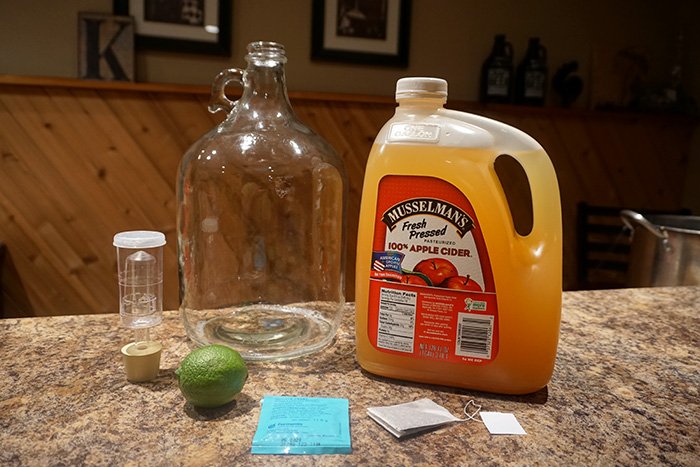Let’s face it, even when making challenging lifestyle changes, we sometimes need a drink! Finding a keto friendly hard cider can be a challenge when searching the local beer store because they all seem to be packed with sugar. On average, a commercial hard cider has 15-25 grams of sugar! Not only that to sweet for my liking, it also makes me feel like crap and makes me fat. I mean, who has just one?
This homemade cider recipe is the solution to a keto friendly cider that is still sweet and an alternative to the sugar packed commercial ciders.

To do this, ferment the cider to dry, or zero sugar, and back sweeten with a low-calorie sweetener like stevia or xylitol. Although the cider will still have carbs from the alcohol, you will be able to enjoy it without a huge load of sugar.
Keep in mind, many homemade hard ciders do not taste like commercial ciders. This is due to not only the sugar content but other additions made before packaging such as apple flavor extracts. To achieve a similar flavor, if that’s your goal, you can add a natural apple extract at the time of back sweetening.
Note: Great apple flavors can be achieved without adding extracts by starting with high quality juice and aging the cider. If you have the patients, aged cider is well worth the wait!
How to Make Low Carb Hard Cider:
If you are new to cider making, winemaking or brewing, follow the standard cider making instructions found here to learn the basics.
Start by making a standard batch of hard cider. I do not suggest raising the original gravity too much as the higher alcohol level will require longer aging to mellow out the flavor of the hard cider.
Once you have a fermented cider that has finished dry, around 1.000 specific gravity, you will be ready for flavor and back sweetening.
When I back sweetened my low carb cider I have tested several products including stevia powder. I added 16 grams per gallon in one batch and 32 grams per gallon in another. I preferred the 16 g/gal batch as I could notice a very distinct stevia aftertaste in the 32 g/gal batch and also thought it was a bit too sweet. More experimenting is required on my end!
If you already follow a ketogenic diet, then you will probably be familiar with many low-calorie and low carb sweeteners. If you have a favorite, there is a good chance that it is nonfermentable but do some research on the product to make sure. If the sweetener is fermentable, the yeast will continue to eat the sugar. If the cider is bottled with too much fermentable sugar it can lead to exploding bottles!
Be careful!
Non-Fermentable Sweeteners
- Erythritol
- Stevia
- Xylitol
- Lactose
- Sucralose
Additional details on back sweetening cider can be found here.
Apple Extract for Flavoring Cider
If you choose to add the organic apple extract, it is very potent with a recommended dose of 1/4 tsp per gallon of cider. I do not suggest using more or you will end up with an artificial candy apple flavored cider. A little goes a long way!
Keto Hard Cider Recipe
Materials
- 1 gal Apple Cider
- 1 tsp Yeast Nutrient
- 1/4 pack Champagne Yeast
- grams Erythritol Sweetener To taste
Instructions
- Clean and sanitize all cider making equipment before starting.
- Pour the apple juice into the fermenting vessel.
- Take a hydrometer reading to measure the original gravity and record.
- Add yeast nutrient if desired.
- Pour the yeast into the fermenter.
- Close the fermenter and install an airlock filled with sanitizer.
- Allow the cider to ferment in a cool and dark place for about two weeks.
- Cold crash and rack to a clean vessel.
- Add desired amount of Erythritol to achieve sweetness.
- Add priming sugar and bottle or go straight to a keg







How do I make a very low calorie cider
This is pretty much a “low calorie” cider. Macronutrients have the following calorie/mass ratio:
protein: 4kcal/g
carb: 4kcal/g
alcohol*: 7kcal/g
fat: 9kcal/g.
In cider making, the protein & fat content is pretty much a non-issue. You can tweak the alcohol (by tweaking the starting carbs==sugars, and perhaps stopping fermentation at a given point) and by tweaking the finishing carbs==sugars (if you stop the fermentation before the cider is dry, there will be residual carbs, plus any you add later.)
So to make a low(er) calorie cider, target your alcohol level, put in only enough sugars to reach that alcohol level, then stabilize (kill the yeast) and back-sweeten with a low-cal sweetener to bring the final product to a pleasing-to-you balance.